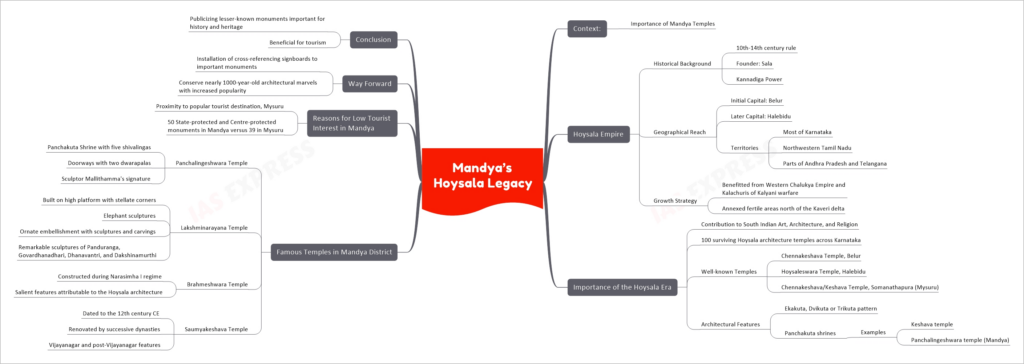Mandya’s Hoysala Legacy
From Current Affairs Notes for UPSC » Editorials & In-depths » This topic
IAS EXPRESS Vs UPSC Prelims 2024: 85+ questions reflected
Mandya district in Karnataka is home to a rich and underrated heritage of Hoysala temples. Despite their historical significance and architectural splendor, these temples often go unnoticed in the shadow of more famous tourist destinations in the region.
Hoysala Empire: A Brief Overview
The Hoysala Empire, founded by Sala, a Kannadiga power, ruled over most of present-day Karnataka from the 10th to the 14th centuries. The empire initially had its capital in Belur and later shifted to Halebidu. The Hoysalas gained control of fertile regions north of the Kaveri delta through warfare with the Western Chalukya Empire and the Kalachuris of Kalyani. By the 13th century, they had expanded their dominion to encompass most of Karnataka, the entire northwestern parts of Tamil Nadu, and parts of western Andhra Pradesh and Telangana.
Importance of the Hoysala Era
The Hoysala era played a crucial role in the development of South Indian art, architecture, and religion. The empire’s patronage of the arts led to the creation of remarkable Hoysala temples, with over 100 surviving examples scattered across Karnataka. These temples stand as testaments to the architectural prowess and creative excellence of the Hoysala dynasty.
Architectural Features of Hoysala Temples
The distinctive architectural style of Hoysala temples sets them apart. The majority of these temples follow the ekakuta, dvikuta, or trikuta pattern, featuring a single, double, or three garbhagrihas (sanctum sanctorum). Some temples, known as Panchakuta shrines, have five sanctums. Two notable examples of Panchakuta shrines are the Keshava Temple and the Panchalingeshwara Temple in Mandya.
Famous Temples in Mandya District
Mandya district boasts several remarkable Hoysala temples that deserve greater recognition. Among them, the Panchalingeshwara Temple stands out with its Panchakuta shrine housing five shivalingas. The temple is adorned with exquisite carvings, and its entrance is guarded by impressive dwarapalas, a signature feature of the Hoysala period sculptor Mallithamma.
Another noteworthy temple is the Lakshminarayana Temple, characterized by its elevated platform and stellate corners adorned with elephant sculptures, which are typical of Hoysala temples. The temple’s interiors and outer walls are lavishly decorated with intricate sculptures and carvings. Wall panels display remarkable depictions of Panduranga, Govardhanadhari, Dhanavantri, and Dakshinamurthi.
The Brahmeshwara Temple, built during the reign of Narasimha I, exemplifies the architectural excellence of the Hoysala dynasty. It showcases intricate carvings and sculptures that reflect the distinct Hoysala style.
The Saumyakeshava Temple, dating back to the 12th century CE, is another noteworthy structure in Mandya. Renovated by successive dynasties, the temple exhibits a fusion of Vijayanagara and post-Vijayanagara architectural elements, offering glimpses into different historical periods.
Reasons for Limited Tourist Popularity
The limited tourist popularity of Mandya’s Hoysala temples can be attributed to several factors. Firstly, the district is located in close proximity to Mysuru, a renowned tourist destination that attracts a significant number of visitors. As a result, Mandya’s heritage sites often get overshadowed by the allure of Mysuru’s attractions.
Furthermore, Mandya’s 50 State-protected and Centre-protected monuments have been overlooked in terms of promotion and tourism infrastructure. Lack of proper signage and information in high footfall areas further contributes to the limited awareness and appreciation of these architectural marvels.
Way Ahead
To enhance the recognition and popularity of Mandya’s Hoysala temples, it is essential to implement certain measures. Installing signboards in high footfall areas that cross-reference important monuments would provide visitors with information and create awareness about the rich heritage present in the district. Additionally, increased promotion and marketing efforts should be undertaken to attract tourists and highlight the historical and cultural significance of these lesser-known sites.
Moreover, conservation efforts for these architectural marvels should be strengthened. Preservation and restoration initiatives, supported by government bodies and heritage organizations, can ensure the long-term survival of these temples and protect them from the ravages of time.
Conclusion
The Hoysala legacy in Mandya district, Karnataka, is a testament to the remarkable artistry and architectural brilliance of the Hoysala dynasty. These temples played a pivotal role in the development of South Indian art, architecture, and religion. While Mandya’s Hoysala temples may currently be underrated and overshadowed by neighboring attractions, they hold immense historical and cultural value. By increasing awareness, promoting tourism, and implementing conservation measures, we can ensure that these temples receive the recognition they deserve. Exploring these lesser-known monuments not only offers a glimpse into the past but also preserves a slice of history and heritage for future generations.
If you like this post, please share your feedback in the comments section below so that we will upload more posts like this.


